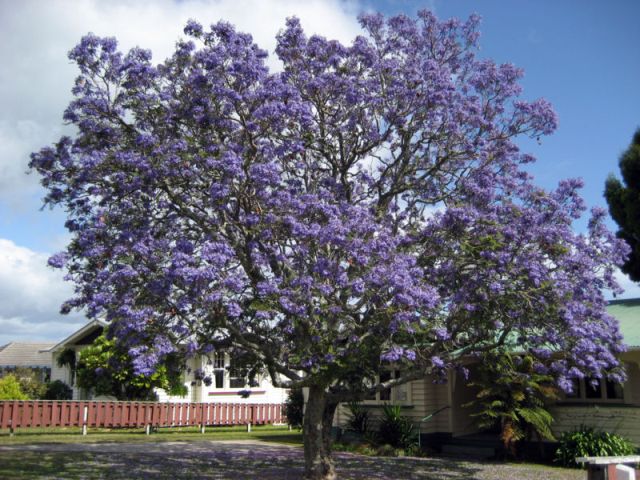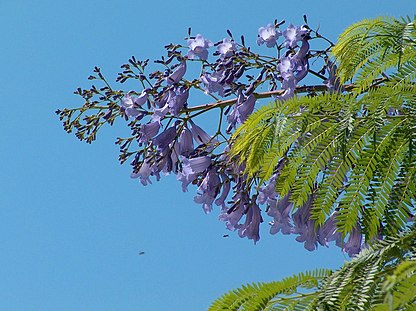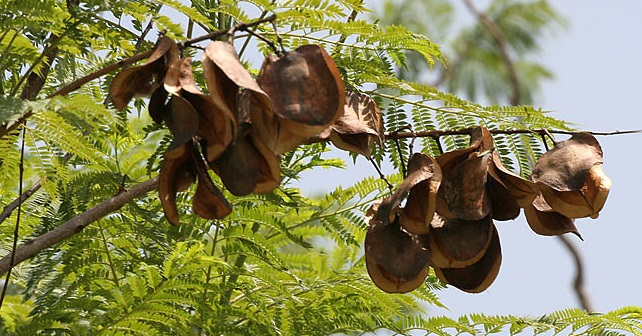TOP


CASTELLANO:
ARRIBA
JACARANDA MIMOSIFOLIA
Con la llegada de la primavera y el otoño, se inicia un espectáculo maravilloso: la floración del jacarandá adorna paseos, parques y aceras con sus ramilletes de flores violetas y azules. Este árbol se conoce científicamente como Jacaranda mimosifolia. Es originario del clima subtropical de América del Sur (Argentina y Brasil). Por su floración y por tener unas raíces poco invasivas, se elige el jacarandá para adornar espacios públicos. Gracias a sus dos floraciones, una en mayo-junio y otra en septiembre-octubre, podemos disfrutar de su belleza durante un larguísimo periodo de tiempo.

El jacarandá es un árbol de hoja caduca, pero se conservan en la planta casi todo el año. Las hojas son grandes, de 3 a 5 cm de longitud, Únicamente las pierde durante el periodo mas frío del invierno. Puede medir entre los 9 y los 15 metros de altura. Su tronco es delgado, de unos 70 cm de diámetro, y puede mostrarse un poco inclinado. Cuando es joven, la corteza tiene una textura lisa, pero, con el paso de los años, se vuelve áspera. Su copa no tiene una forma uniforme: algunas veces aparece en forma de sombrilla, y otras en forma piramidal, pero nunca densa.

Necesita de un clima cálido para que se desarrolle bien, pero puede vivir tanto a pleno sol como en semi sombra. Sin embrago, es poco exigente con el suelo en el que vive. Incluso puede soportar algo de sequía.
Otra curiosidad del jacarandá es su fruto: una cápsula plana y dura, de color marrón oscuro, de unos 5 cm de diámetro. Estos frutos se mantienen en el árbol todo el año y se abren en dos al madurar, para dejar caer la semilla de su interior. Las semillas que aparecen son marrones y provistas de ala.
Este fruto recuerda una castañuela. Quizá por eso se define como "jacarandoso" a una persona o situación alegre. ¿No se suele decir también "más feliz que unas castañuelas"? En cualquier caso, aunque estas castañuelas no suenen, es cierto que este árbol nos alegra la vista.

EL CACHÉ
El caché esta completamente integrado y camuflado en el entorno. No es necesario escalar. En este caso se puede decir que la paciencia es una gran virtud.
ENGLISH:
TOP
JACARANDA MIMOSIFOLIA
With the arrival of spring and autumn, a wonderful spectacle begins: the flowering of the Jacaranda tree adorns walks, parks and sidewalks with their bouquets of violet and blue flowers. This tree is scientifically known as Jacaranda mimosifolia . It comes from the subtropical climate of South America (Argentina and Brazil). Due to its flowering and to have few invasive roots, the jacarand is chosen. to decorate public spaces. Thanks to its two blooms, one in May-June and another in September-October, we can enjoy its beauty for a long period of time.

The jacarand is a deciduous tree, but they are conserved in the plant almost all the year. The leaves are large, 3 to 5 cm length, and it only lose them during the coldest winter period. It can measure between 9 and 15 meters height. Its trunk is thin, about 70 cm in diameter, and it may be slightly inclined. When it is young, the bark has a smooth texture, but, with the passing of the years, it becomes sappy. Its cup does not have a uniform shape: sometimes it appears as an umbrella, and sometimes pyramidal, but never dense.

However, it is not very demanding with the soil in which it lives. It can even withstand some drought.
Another curiosity of the jacarand is its fruit, that is flat, hard and dark brown, of about 5 cm in diameter. These fruits are kept in the tree all year long and open in two as they ripen, to drop the seed from inside. The seeds that appear are brown and provided with wing.
This fruit resembles a castanet. This is why 'jacarandoso' defines a cheerful person or situation. Did you ever heard about someone who is 'happier than a castanet'? (This Spanish expression means 'happy as a clam'). In any case, even though these castanets have no sound, you really can say this tree makes us happy in sight.

THE CACHE
The Cache is completely integrated and camouflaged in the environment. It is not necessary to climb. In this case it can be said that patience is a great virtue.